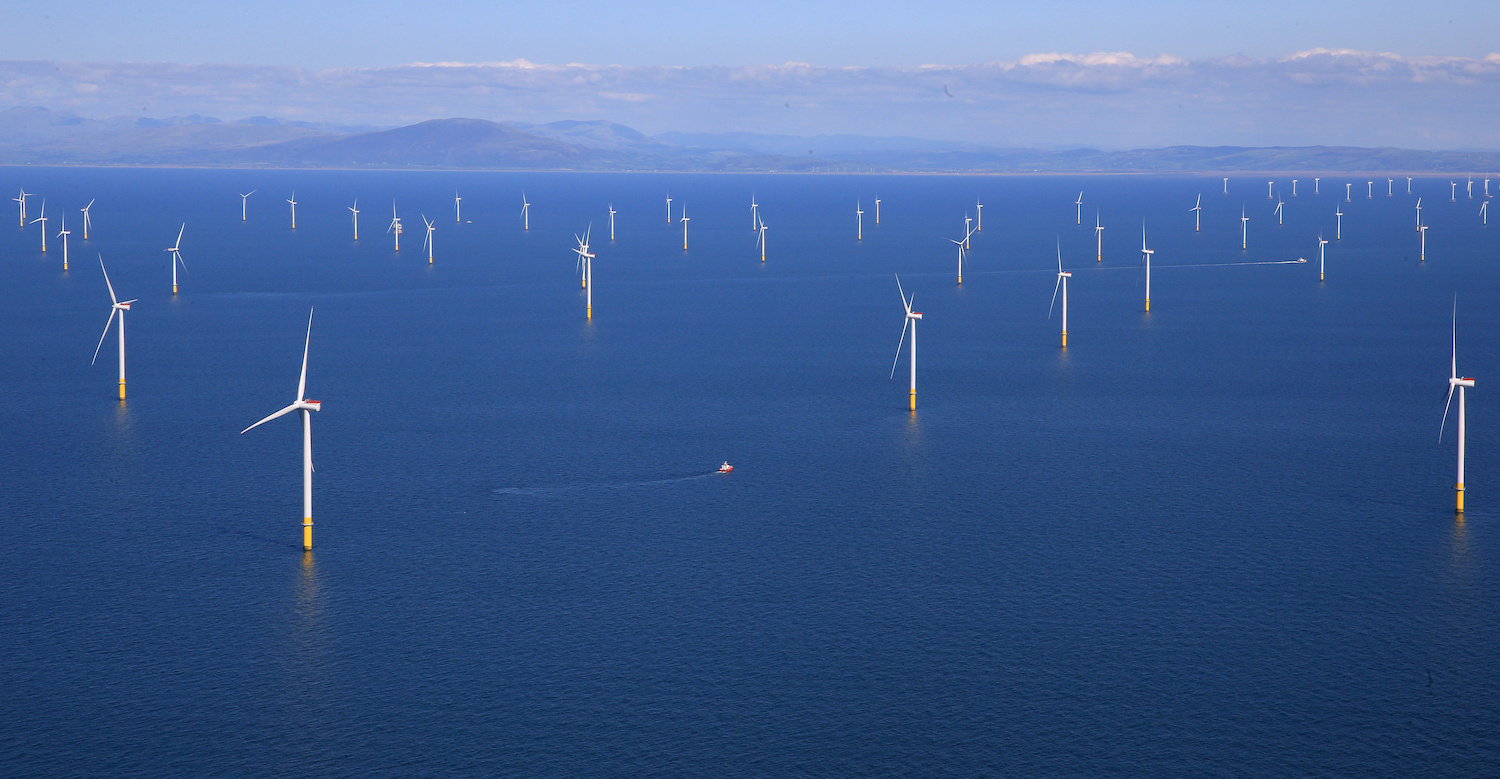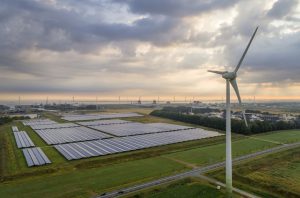A giant wind-farm off the south coast is one of more than 150 wind power projects planned in Vietnam; the 1GW Vinh Phong project will be funded by a Russian-Belgian JV, but Hanoi needs to improve its clunky electricity grid so renewable projects can be fully incorporated in coming years
(AF) A plethora of international players are beating a path to Vietnam to take part in its renewables ramp-up – the largest in Southeast Asia – which includes both solar and onshore wind and now even an offshore wind project development.
The most recent to show interest includes Russian state-owned oil and gas producer Zarubezhneft and Belgian marine contractor DEME Offshore.
Early this week, the two signed a memorandum of understanding (MoU) to build the proposed Vinh Phong project, a 1-gigawatt (GW) offshore wind farm proposal with a cost of $3.2 billion. Vinh Phong is located in southern Vietnam, northeast of Ho Chi Minh City, the country’s business hub.
The two partners look to commission the first phase of the project, with 600-megawatts (MW) worth of capacity, by 2026, prior to a second phase with a further 400MW capacity by 2030. If plans hold tight, it could be Vietnam’s first offshore wind farm and it is anticipated that more will follow.
Zarubezhneft said it will share investment costs with a specially formed investment vehicle called DEME Concessions Wind. Under the MoU, the two firms will get oil and gas producing venture Vietsovpetro and DEME Offshore to manage the construction process.
Vietsovpetro, a joint venture between Zarubezhneft and state-run PetroVietnam, already operates several offshore oil and gas blocks in Vietnam.
In 2019, Zarubezhneft set a goal of entering both the wind and solar sector in Vietnam, Cuba, Southern Europe and Russia. These plans, not surprisingly, suffered setbacks due to the onset of the Covid-19 pandemic last year and a subsequent pullback in global oil prices amid the worst slump in demand for oil ever, which caused a drop to multi-year lows. However, global oil prices have recovered, with the global oil benchmark, London-traded Brent crude, now hovering above $70 per barrel, with price appreciation and forecasts that demand will increase for the rest of the year.
Vietnam’s clean energy transition
Zarubezhneft’s disclosure comes as Vietnam undergoes systemic changes in its energy sector. This stems from a forecast natural gas supply shortage that will impact its power generation capacity with potential brown and black-outs, mostly earmarked for the more populated south. However, Covid-19 related economic contraction has pushed that forecast back at least a year or two.
Vietnam’s energy quandary also stems from steady economic growth and more energy consumption, as well as geopolitical interference. Over the past several years, China has prevented PetroVietnam and its foreign partners from developing natural gas resources in Vietnam’s own UN-mandated 200 nautical mile exclusive economic zone (EEZ) in the South China Sea, a problem not dissimilar to that faced by the Philippines.
To offset this supply shortage, Hanoi initially focused on developing more liquefied natural gas (LNG) infrastructure. Currently, two LNG import terminals are being constructed in the southern part of the country, with at least six more approved, and possibly more considering projects pending approval at various provincial levels. Vietnam also has as many as 22 LNG-to-Power projects in its soon to be released Power Development Plan 8 (PDP8), to 2030 with guidance to 2045.
Over 150 wind projects proposed
Vietnam has marked advantages in its renewables ambitions over many of its neighbors in the region, including a vast coastline of some 3,260 km (2,030 miles), excluding islands – ideal for both offshore and near-shore wind-power development. By way of comparison, only around 3% of neighbouring Thailand’s land mass has suitable wind speeds needed to drive turbines, which greatly hinders the country’s capacity to develop wind power.
Vietnam’s solar radiation in most parts of the country is also ideal for solar project development, and has contributed to its quick build-out, which seems to have peaked last year.
Much of the country’s recent success with solar can also be attributed to Hanoi approving generous feed-in-tariffs (FIT). These tariffs encourage investment in renewable energy by guaranteeing an above-market price for producers. Since they usually involve long-term contracts, FITs help mitigate the risks inherent in renewable energy production.
The government has also approved FITs for its wind-power development, with those tariffs up for review at the end of October. It also offers various tax exemptions to reduce investment risks.
Yet, Vietnam’s wind power development pales in comparison to its solar build-out. By the end of 2020, wind power accounted for just 1% (670MW) of the country’s energy mix, compared to 16.6GW for solar, including rooftop solar, according to the US Energy Information Administration (EIA). Under PDP8, the next power development plan, the country aims to ramp-up solar capacity to 18.6GW and wind capacity to 18GW by 2030. Vinh Phong, for its part, is one of as many as 157 wind farm projects proposed in Vietnam.
Three weeks ago, the Asian Development Bank (ADB) signed a $116-million loan with three Vietnamese firms to finance the construction and operation of three 48MW wind farms, totaling 144MW, in the central province of Quang Tri.
The projects will increase Vietnam’s wind-power capacity by as much as 30%, helping it to also offset the country’s still troubling reliance on coal needed for power generation. Coal still makes nearly 40% of the country’s energy mix, and that figure looks likely to remain steady until to at least the middle of the next decade.
The ADB’s move three weeks ago was its first wind-power project in Vietnam and comes just a month after the bank said it would stop funding most fossil fuel projects in the region, even natural gas, under most scenarios.
Electricity grid needs urgent improvements
However, as promising as Vietnam’s renewables build-out is, several problems remain, including power grid curtailment. Simply put, the country needs new transmission and distribution infrastructure to accommodate additional capacity and transmit the new power to where it’s needed.
The problem is already being felt by a number of power projects that have had to curtail production since transmission lines are already operating at capacity, especially in areas where there is a concentration of solar power. This has resulted in less electricity being produced, less revenue earned and an inability of some project backers to service debts incurred to build projects.
Similar problems – depending on each location’s specific grid development – could see otherwise bankable wind power projects, (onshore, near-shore and offshore) unable to obtain necessary funding to go forward.
But the Vietnamese government is now starting to address this problem. It recently adopted a new law that improves and prioritizes grid development. And grid development is now a priority in the draft PDP8, the first time it’s been included in the country’s PDP.
However, expanding grid capacity is both capital and time intensive. Build-out times can range to as much as five years or more. Other countries are also confronting similar situations when building renewable power projects, including heavyweights such as Germany and the UK.
There are some short-term solutions for grid congestion, however, such as utility scale battery storage, grid enhancing techniques, plus topology optimization software. All of these improve grid resilience and reliability, and prevent bottlenecks, but the long-term solution is still expanding Vietnam’s transmission grid.
ALSO SEE:
Vietnam’s uneven green energy push just became murkier






















